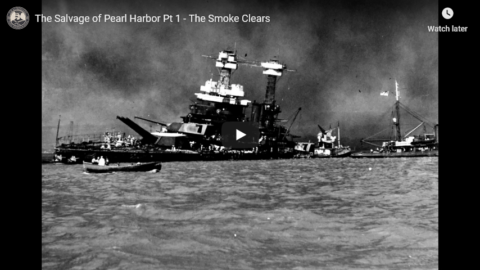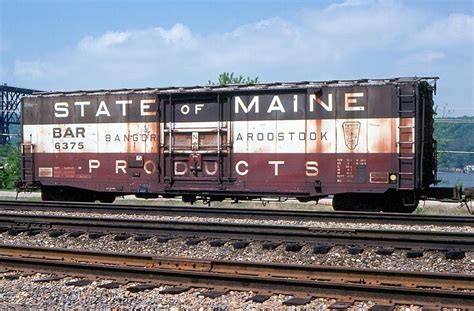Drachinifel
Published 11 Nov 2020Today we look at the start of the salvage efforts in the aftermath of the attack on Pearl Harbour.
Sources:
www.amazon.co.uk/gp/product/B00C0JIXJO
https://www.history.navy.mil/our-coll…
www.amazon.co.uk/Pearl-Harbor-Fleet-Salvage-Appraisal/dp/0898755654
www.amazon.co.uk/Descent-into-Darkness-Harbour-Divers/dp/0891417451Free naval photos and more – www.drachinifel.co.uk
Want to support the channel? – https://www.patreon.com/Drachinifel
Want a shirt/mug/hoodie – https://shop.spreadshirt.com/drachini…
Want a poster? – https://www.etsy.com/uk/shop/Drachinifel
Want to talk about ships? https://discord.gg/TYu88mt
Want to get some books? www.amazon.co.uk/shop/drachinifelDrydock
Episodes in podcast format – https://soundcloud.com/user-21912004
December 9, 2020
The Salvage of Pearl Harbor Pt 1 – The Smoke Clears
The late steam-era boxcar and (a brief) flourish of colour
In his Trains blog, George Hamlin discusses the changing colours of the ordinary railway boxcar in the brief era between post-war prosperity and the economic disasters of the 1960s and 70s:

Pre-war Duluth, South Shore & Atlantic boxcar number 18052 at the Mid-Continent Railway Museum.
Photo by Sean Lamb via Wikimedia Commons.
The advent of streamlining in the 1930s started to blow historic convention with regard to car colors away on the passenger side of railroading, but had little impact on freight operations prior to World War II. Following that conflict, however, some of the industry began to consider livening up the equipment that produced much of the revenue (and most of the profits) from which they derived their economic existence.
Some railroads also adopted more colorful boxcar paint schemes to promote special aspects of their freight service: the B&O had special schemes for both their “Sentinel” and “Timesaver” services; another example was the Missouri Pacific’s blue and gray (the road’s modern-day passenger colors) for their Eagle Merchandise Service. The Bangor & Aroostook had boxcars with red, white and blue horizontal stripes advertising products emanating from their home state, Maine.
Bangor and Aroostook boxcar 6375 in “State of Maine” paint scheme.
Image originally from Panoramio, but no user information provided.Another example was the large fleet of New York Central’s “Pacemaker” boxcars, adorned in a combination of bright red and gray. Early on, the NYC even ran solid trains of this equipment in an expedited service which was designed to re-capture LCL (less than carload lot) traffic from the increasingly competitive motor trucking industry. (Interestingly, the NYC also had a color they called “Pacemaker Green” that was used for the pre-World War II all-coach New York-Chicago service, as well as on the road’s initial orders of non-stainless steel streamlined coaches.)
In the late 1950s, the Central introduced a more radical change, and began painting its boxcars in a Jade Green color (“Century Green”, according to the railroad) that was quite a dramatic change from boxcar red. The Great Northern also adopted a similar shade. CB&Q boxcars still had the same basic hue, but now they came in a brighter version dubbed “Chinese Red”.
By the 1960s, a number of roads had livened up their freight car liveries; the modestly-sized Reading utilized bright green and beige/yellow for both freight cars and locomotives. Late in its career as an independent railroad, the Great Northern adopted the striking bright “Big Sky Blue” for both passenger and freight cars. At its formation in 1976, Conrail adopted “traditional red oxide” as its choice for freight cars, however, sticking with tradition (and reversing the NYC’s earlier efforts).
Historical Models Summarized: The Military Expedition
Overly Sarcastic Productions
Published 18 Feb 2016Today, Blue discusses recurring themes in history! This one’s the Military Expedition, aka what happens when a powerful military juggernaut gets too big for its britches and starts saying stuff like “too big to fail” unironically.
Blue: If you’re curious about the weird chart/graph thing blue showed during the Napoleon segment, look up Charles Joseph Minard [mentioned here and here], the guy who made it. It’s a really cool chart that shows the size of the army as it traveled across Russia (tan) and back (black). You can see how perilous the journey was based on how narrow the line gets. Graphs are cool.
QotD: The rise of bebop
The problem goes back to the early 40s, when a revolution took place in jazz. At a Harlem club named Minton’s, while the swing era was still in full bloom, a group of musicians began experimenting with a new approach to the music. Bandleader Teddy Hill formed a house band with drummer Kenny Clarke, trumpeter Dizzy Gillespie, and pianist Thelonious Monk. During nightly jam sessions others would join them, most notably sax great Charlie Parker, who had gotten his start in the swing bands of Kansas City. Vats of ink have been spilled deciphering the meaning of bebop. If jazz writers are to be believed, it defies easy categorization and requires sets and subsets to understand, but a succinct four-part summary was offered by Neil Tesser in The Playboy Guide to Jazz a couple years ago. First, the beboppers used small, quick combos — most often of trumpet and sax backed by piano, bass, and drums — instead of orchestras. Second, they used more complex chords, exploring “lively, colorful combinations of notes that previous listeners considered too dissonant for jazz.” Third, they often abandoned the melody of a song in order to improvise, relying more heavily on the song’s harmony.
Fourth, beboppers had attitude: “Instead of smooth and hummable melodies designed for dancing, the beboppers created angular tunes with unexpected accents and irregular phrases — and they expected people to listen, rather than jitterbug, to these songs and the solos that followed. The boppers emerged as jazz’s first ‘angry young men.’ They saw themselves as artists first and entertainers second, and they demanded that others respect them and their music accordingly.”
Some of the new jazz was undeniably brilliant, and many of the bebop and hard bop recordings that have been remastered and reissued only seem to acquire more appeal with age. Albums like Parker’s Now’s the Time, Art Blakey and the Jazz Messengers, Dexter Gordon’s Go, Sonny Rollins Vol. 2, and Coltrane’s Blue Train are timeless, bristling with energy, jaw-dropping improvisation, and deep spirituality. But when they cast their spell, they laid complete waste to the pop-jazz tradition. Bebop offered challenges musicians thought they could never get from traditional swing bands, as well as an improvisational ethic that provided an escape from the tough work of writing strong melodies. Some of the players saw this: In 1949 drummer Buddy Rich fired his band because his players “just want to play bop and nothing else. In fact,” Rich added, “I doubt they can play anything else.” Louis Armstrong, whose centennial is being celebrated this year, once referred to bebop as “crazy, mixed-up chords that don’t mean nothing at all.” Before long swing had become a joke. Producer Quincy Jones recalls in the documentary Listen Up that as a young musician he once hid backstage from bebop trumpeter Miles Davis so Miles wouldn’t know he was in the swinging band that had just left the stage.
Suddenly, jazz was Art. Gone were the days when 5,000 people would fill the Savoy Ballroom to lindy hop to the sunny sounds of Ella Fitzgerald or Count Basie. Bebop was impossible to dance to, which was fine with the alienated musicians in Eisenhower’s America. (You can bet this era will be well represented by beatnik [Ken] Burns [in his then-unreleased Jazz documentary TV series].) Even bebop’s own founders weren’t safe from the ideological putsch: when Bird himself made an album of pop standards with a band backed up by a string section, he was labeled a sellout. Then Elvis, to simplify matters greatly, reinvented swing for a new generation, and the Beatles arrived with sacks of great new melodies, and jazz was over as a popular music. Remarkably, beboppers and their fans still blame the drop-off on American racism. Miles once called pop music “white music,” and Kareem Abdul-Jabbar, in a documentary about the Blue Note label, offers that “whites couldn’t appreciate anything that came from black culture.” Yet whites were as responsible as blacks for making stars of Ella, Basie, and other black swing artists. Only two kinds of music were allowed on the radio following the news of FDR’s death: classical and Duke Ellington.
Mark Gauvreau Judge, “Out of Tunes”, Chicago Reader, 2000-08-31.







